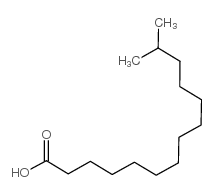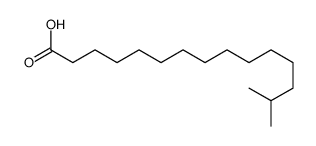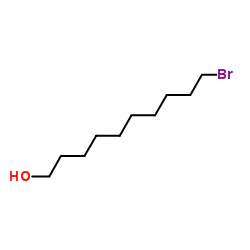13-Methyltetradecanoic acid

13-Methyltetradecanoic acid structure
|
Common Name | 13-Methyltetradecanoic acid | ||
|---|---|---|---|---|
| CAS Number | 2485-71-4 | Molecular Weight | 242.40 | |
| Density | 0.894 g/cm3 | Boiling Point | 355.5ºC at 760 mmHg | |
| Molecular Formula | C15H30O2 | Melting Point | N/A | |
| MSDS | Chinese USA | Flash Point | 197.4ºC | |
| Symbol |

GHS07 |
Signal Word | Warning | |
Use of 13-Methyltetradecanoic acid13-Methyltetradecanoic acid (13-MTD), a saturated branched-chain fatty acid with potent anticancer effects. 13-Methyltetradecanoic acid induces apoptosis in many types of human cancer cells[1][2]. |
| Name | isopentadecanoic acid |
|---|---|
| Synonym | More Synonyms |
| Description | 13-Methyltetradecanoic acid (13-MTD), a saturated branched-chain fatty acid with potent anticancer effects. 13-Methyltetradecanoic acid induces apoptosis in many types of human cancer cells[1][2]. |
|---|---|
| Related Catalog | |
| In Vitro | 13-Methyltetradecanoic acid (13-MTD; 0-140 μg/mL; 12-24 hours) inhibits cell viability and proliferation in human bladder cancer cells by inducing apoptosis[1]. 13-Methyltetradecanoic acid (13-MTD; 70 μg/mL; 2-48 hours) treatments results in significant accumulation of cells with sub-G1 DNA content in a time-dependent manner, with the proportion of sub-G1 phase DNA content ranging from 9.25% to 85.3% over 2-48 hours[1]. 13-Methyltetradecanoic acid (13-MTD; 70 μg/mL; 2-24 hours) down-regulates Bcl-2 and up-regulates Bax. This promotes mitochondrial dysfunction, leading to the release of cytochrome c from the mitochondria to the cytoplasm, as well as the proteolytic activation of caspases. 13-Methyltetradecanoic acid down-regulates AKT phosphorylation and activates phosphorylation of p38 and c-Jun N-terminal kinase (JNK)[1]. Cell Viability Assay[1] Cell Line: Bladder cancer cell lines T24, 5637, and UM-UC-3 Concentration: 0 μg/mL, 35 μg/mL, 70 μg/mL, 105 μg/mL, and 140 μg/mL Incubation Time: 12 hours, 24 hours Result: Inhibition of cell viability in a dose- and time-dependent manner. Cell Cycle Analysis[1] Cell Line: Bladder cancer cell lines T24, 5637, and UM-UC-3 Concentration: 70 μg/mL Incubation Time: 2 hours, 8 hours, 24 hours, or 48 hours Result: Resulted in significant accumulation of cells with sub-G1 DNA content in a time-dependent manner. Western Blot Analysis[1] Cell Line: T24, 5637, and UM-UC-3 cells Concentration: 70 μg/mL Incubation Time: 2 hours, 8 hours, 24 hours Result: Down-regulated Bcl-2 and up-regulated Bax, and down-regulated AKT phosphorylation and activated phosphorylation of p38 and c-Jun N-terminal kinase (JNK). |
| In Vivo | 13-Methyltetradecanoic acid (13-MTD; 70 mg/kg/day; oral gavage; daily; for 30 days) significantly suppresses tumor growth in a xenograft model[2]. Animal Model: BALB/C nude mice injected with Jurkat lymphoma cells[2] Dosage: 70 mg/kg/day Administration: Oral gavage; daily; for 30 days Result: Effectively inhibited the growth in vivo in a xenograft model. |
| References |
| Density | 0.894 g/cm3 |
|---|---|
| Boiling Point | 355.5ºC at 760 mmHg |
| Molecular Formula | C15H30O2 |
| Molecular Weight | 242.40 |
| Flash Point | 197.4ºC |
| Exact Mass | 242.22500 |
| PSA | 37.30000 |
| LogP | 5.01810 |
| Vapour Pressure | 5.19E-06mmHg at 25°C |
| Index of Refraction | 1.451 |
| Storage condition | 2-8°C |
| Symbol |

GHS07 |
|---|---|
| Signal Word | Warning |
| Hazard Statements | H315-H319-H335 |
| Precautionary Statements | P261-P305 + P351 + P338 |
| Personal Protective Equipment | dust mask type N95 (US);Eyeshields;Gloves |
| Hazard Codes | Xi: Irritant; |
| Risk Phrases | 36/37/38 |
| Safety Phrases | 26-36 |
| RIDADR | NONH for all modes of transport |
| WGK Germany | 3 |
| HS Code | 2915900090 |
| Precursor 8 | |
|---|---|
| DownStream 5 | |
| HS Code | 2915900090 |
|---|---|
| Summary | 2915900090 other saturated acyclic monocarboxylic acids and their anhydrides, halides, peroxides and peroxyacids; their halogenated, sulphonated, nitrated or nitrosated derivatives VAT:17.0% Tax rebate rate:9.0% Supervision conditions:AB(certificate of inspection for goods inward,certificate of inspection for goods outward) MFN tariff:5.5% General tariff:30.0% |
|
Melanogenesis of methyl myristate loaded niosomes in B16F10 melanoma cells.
J. Biomed. Nanotechnol. 9(4) , 626-38, (2013) The objective of this study was to compare the charge effect of methyl myristate loaded in neutral (Brij 72/cholesterol at 7:3), cationic (Brij 72/cholesterol/dimethyl dioctadecyl ammonium bromide at ... |
|
|
Methyl-branched poly(hydroxyalkanoate) biosynthesis from 13-methyltetradecanoic acid and mixed isostearic acid isomer substrates.
Appl. Microbiol. Biotechnol. 85 , 359-370, (2009) Pseudomonas resinovorans, a known medium-chain-length (mcl-) poly(hydroxyalkanoate) (PHA) producer, was grown on 13-methyltetradecanoic acid (13-MTDA) and a mixture of isostearic acid (IA) isomers to ... |
|
|
13-Methyltetradecanoic acid induces mitochondrial-mediated apoptosis in human bladder cancer cells.
Urol. Oncol. 30(3) , 339-45, (2010) 13-Methyltetradecanoic acid (13-MTD), a saturated branched-chain fatty acid purified from soy fermentation products, is known to induce apoptosis in many types of human cancer cells. This study was de... |
| 13-Methylmyristic acid |
| 13-METHYLTETRADECANOIC ACID |
| 13-Methyltetradecanoic acid |
 CAS#:95799-79-4
CAS#:95799-79-4 CAS#:75853-51-9
CAS#:75853-51-9 CAS#:51166-20-2
CAS#:51166-20-2 CAS#:20194-48-3
CAS#:20194-48-3 CAS#:4669-02-7
CAS#:4669-02-7 CAS#:53463-68-6
CAS#:53463-68-6 CAS#:4548-78-1
CAS#:4548-78-1 CAS#:14065-32-8
CAS#:14065-32-8 CAS#:170242-21-4
CAS#:170242-21-4 CAS#:83549-87-5
CAS#:83549-87-5 CAS#:5129-59-9
CAS#:5129-59-9 CAS#:64317-63-1
CAS#:64317-63-1